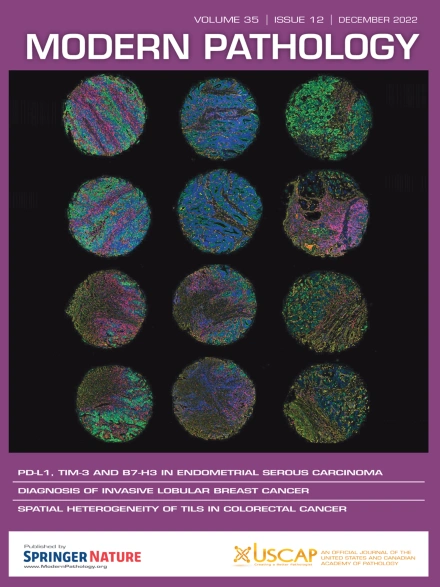HER2阳性乳腺癌新辅助治疗中的分子景观、基因组转移和预测。
IF 5.5
1区 医学
Q1 PATHOLOGY
引用次数: 0
摘要
人表皮生长因子受体2 (HER2)的扩增或过表达定义了乳腺癌(BC)亚型,该亚型受益于新辅助HER2靶向治疗。然而,至少有40%的患者对治疗反应不佳或无反应。我们通过下一代测序分析了64例HER2+患者的主要基因组改变,以确定新的反应预测因子,并将其与临床病理参数相关联。我们还比较了新辅助治疗后原发肿瘤和残留肿瘤的基因组变化。TP53基因是最常见的突变基因,结合ERBB2过表达,两者可预测残余癌症负担(RCB) (p=0.001)。此外,它们的免疫组织化学对应物(p53突变体和HER2的Score3+)的组合可以预测完全的病理反应和反应等级(p=0.038和p=0.031)。因此,p53可以被纳入最初的BC生物标志物,以帮助HER2+病例的治疗决策。本文章由计算机程序翻译,如有差异,请以英文原文为准。
Molecular Landscape, Genomic Shift, and Prediction in the Neoadjuvant Setting of Human Epidermal Growth Factor Receptor 2–Positive Breast Cancer
The amplification or overexpression of human epidermal growth factor receptor 2 (HER2) defines a breast cancer subtype, which benefits from neoadjuvant HER2-targeted therapy. However, at least 40% of patients respond poorly or do not respond to treatment. We analyzed the main genomic alterations of 64 HER2+ patients by next-generation sequencing to identify new predictors of response and correlate them with clinicopathological parameters. We also compared the genomic alterations between primary and residual tumors after neoadjuvant treatment. The TP53 gene was the most frequently mutated gene, and in combination with ERBB2 overexpression, the 2 were predictive of residual cancer burden (P = .001). Furthermore, the combination of their immunohistochemical counterpart (p53 mutant and score 3+ for HER2) can predict complete pathological response and the grade of response (P = .038 and P = .031, respectively). Therefore, p53 could be included in the initial panel of breast cancer biomarkers to help therapeutic decision-making in HER2+ cases.
求助全文
通过发布文献求助,成功后即可免费获取论文全文。
去求助
来源期刊

Modern Pathology
医学-病理学
CiteScore
14.30
自引率
2.70%
发文量
174
审稿时长
18 days
期刊介绍:
Modern Pathology, an international journal under the ownership of The United States & Canadian Academy of Pathology (USCAP), serves as an authoritative platform for publishing top-tier clinical and translational research studies in pathology.
Original manuscripts are the primary focus of Modern Pathology, complemented by impactful editorials, reviews, and practice guidelines covering all facets of precision diagnostics in human pathology. The journal's scope includes advancements in molecular diagnostics and genomic classifications of diseases, breakthroughs in immune-oncology, computational science, applied bioinformatics, and digital pathology.
 求助内容:
求助内容: 应助结果提醒方式:
应助结果提醒方式:


